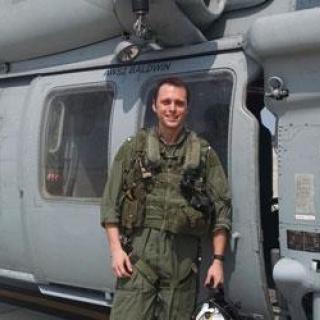Physicians have a long history in the military from treating disease in the Civil War to treating battle wounds in field hospitals in Afghanistan. One emergency medicine resident is training now to become a Naval flight surgeon, and when he completes training, he will attach to a jet and helicopter squadron and deploy with those soldiers as their front line physician. Wherever they go, he will go—and then he will return to residency training.
After doing a one-month rotation in flight surgery last year with the Navy where he spent time on an aircraft carrier and steered a helicopter over the water, Josh Lesko, MD, a former emergency medicine intern in the Navy, decided it was right up his alley and headed to Pensacola, Fla., to continue his training.
“There are a couple of things that have a reputation—one is called 'the dunker,' which is where you are strapped into a helicopter simulator and it’s allowed to sink,” Dr. Lesko said. “When helicopters sink, they turn upside down. So we are about ten feet underwater strapped into the helicopter and have to learn how to get out with full gear on, with black out goggles so we can’t see … to simulate all the different ways we might be in a helicopter when it goes down.”

Training to serve those who serve
There are three tracks for resident physicians in the Navy who decide to complete an operational tour before finishing training. The first, General Medical Officer, is a physician on a ship or in a clinic. The second, Undersea Medical Officer, is a physician attached to a dive unit. And the third, Flight Surgeon, is a physician attached to a flight squadron—which is what Dr. Lesko is training to be.
Several options exist for a flight surgeon, he said. There’s the opportunity to go with the Marines in one of their squadrons as well as isolated helicopter and jet squadrons, which usually have a couple hundred people in the unit.
“Then there are the Carrier Air Groups, which is what I want to be attached to,” he said. “In that case, you are one of two flight surgeons for six or seven different squadrons that comprise both of jets and helo[copters]. So you are on an aircraft carrier when you deploy.”
For flight surgery training, which is treated as a break from residency, Navymen go through three stages. The first phase is the same training that pilots and flight officers go through, which is five weeks of academic work on aerodynamics, weather, navigation, engines, flight rules and regulations.
In the second phase, called primary, they learn how to fly a plane and a helicopter. In the third phase, they spend six weeks learning physiology in abnormal conditions—or aerospace medicine—which teaches the medical trainees how to be better physicians specifically for this unique subset of pilot patients that they will be treating.
“It’s more than just classes,” Dr. Lesko said. “There’s a water survival component where we have to learn how to evacuate from a theoretical sinking ship … emergency egress from a helicopter that’s submerged, and more specific aeronautical tactics.”
“In the Air Force and the Army they don’t do the flight component,” Dr. Lesko said. “But the Navy’s belief is that to really understand what the pilots are going through and be part of the community we have to go through the same training as they do.”
For the majority of flight surgery residents there is a program called the Health Profession and Scholarship Program (HPSP). Residents apply to HPSP simultaneously with medical school, but residents also choose a military branch. If selected for HPSP, tuition and required costs are covered. In return, the resident owes “a year for a year” of service to that military branch. Residents in civilian programs often apply after or during residency. .
“We are really the first line for our squadron,” Dr. Lesko said. “We are their doctor; wherever they go, we go. Any incidents that happen on a plane or on a ship we have to handle. So we’re their clinic doc, but we’re also the safety officer and are part of any investigation into a crash to see if there was a human component that was at fault.”
Physicians who deploy around the world
Any military aircraft that flies will have a flight surgeon attached to it. Marine One, the President’s helicopter, has a flight surgeon dedicated to it. There are international billets in Japan, Italy, Spain, Bermuda, the United Kingdom, and all over the United States.
“You’re going to be in a cool place and doing something fantastic,” Dr. Lesko said. “It’s an honor to be able to treat and serve those who serve and really be there for them and be a part of the mission of the Navy as a global force for good.”
“That’s part of the appeal,” he said. “One of my attendings put it best: What separates us from civilian doctors? Are we just doctors who wear uniforms or are we doctors who are out there training with them and deploying when they deploy? That’s what helped me make up my mind about flight surgery.”




